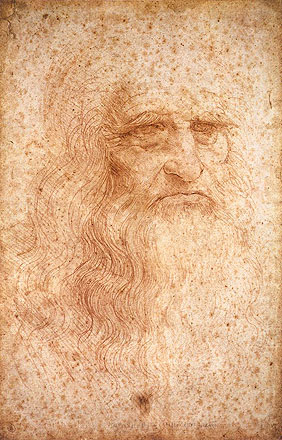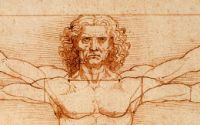Leonardo da Vinci (1452-1519) lived in Florence, Italy, for most of his life and spent much of his time in private studies. He is mostly known for painting the Mona Lisa and The Last Supper, two of the most famous paintings in Western art, but his work as a scientist and inventor is often forgotten. Commonly called a universal genius because of his diverse talents, Da Vinci has inspired artists, architects, and engineers of all disciplines. Biomedical engineering, a field that has only recently grown in industry and academia, can trace its early beginnings to Da Vinci’s curious investigation of the human anatomy.
Da Vinci the Engineer
Leonardo da Vinci (1452 – 1519), well known as an artist, inventor, architect, and anatomist, embodies the quintessential “Renaissance man.” The book The Da Vinci Code, by Dan Brown, and the recently adapted film have made Da Vinci a popular subject, however they mostly highlight his artistic talent. In addition to his time spent as a painter and sculptor, Da Vinci (Fig. 1) devoted his life to thousands of drawings and diagrams dealing with math, science, and engineering, especially as he grew older [1]. Compared with only 10 paintings in art galleries around the world and a few hundred other personal drawings, his notebooks filled with technical drawings are indicative of Da Vinci’s predominant interests [1]. In 1501, an agent of an Italian noblewoman who was pursuing Da Vinci for artistic commission, described him as a man “so much distracted from painting by his mathematical experiments as to become intolerant of the brush” [1].
Driven by unending curiosity and creativity, he designed mechanical devices for manufacturing, war, and transportation. Meanwhile, he mapped out the human body’s internal organs, muscles and bones more thoroughly than anyone before him. Most of Da Vinci’s work was never realized during his lifetime, and unfortunately, other more modern scientists and inventors have taken credit for his ingenuity.
Bridges
In 1502, the Sultan of the Ottoman Empire came to Rome to hire a team of civil engineers to design a bridge to stretch across the Golden Horn at Istanbul. Da Vinci offered his services to the Sultan, modeling a structure in his notebook that represented a beautiful synergy of creative artistry and civil engineering [1].The bridge would have spanned 276 meters of water and the arch would have been high enough for a ship with sails to pass under [1]. Although the Sultan turned down Da Vinci’s proposal, believing the architectural endeavor to be impossible, a modern Swiss scientist, D.F. Stussi, concluded that the plans were “technically feasible” [1]. In 2001, inspired by Da Vinci’s design, an artist in Norway named Vebjorn Sand decided to construct his bridge. Da Vinci’s bridge design stands today over a highway in Norway as a monument to his genius [2].
Da Vinci also influenced later bridge builders with his method of bending wooden beams into arches [1]. He devised a technique of notching timber to prevent splitting and interlocking bent and notched beams to create a bearing arch. More than 300 years later, Swiss bridge builders used Da Vinci’s method in their arched wooden bridges.
Another important engineering idea that Da Vinci can be credited for is the gated canal. His desire to provide Florence with a waterway to the sea led him to the invention of the canal and locks to control water levels [1]. His ingenious sluice gate design works under the same principle as the modern locks of the Panama Canal. The boat enters a lock of the canal, and the lower gate is closed. Then the small trap door in the upper gate is opened and water flows through, raising the water level and the boat in that section of the canal. This water flow equalizes the pressure across the upper gate, thus allowing gate to be opened and the boat moves to the next lock [1].
Engines and Gears
Although James Watt is credited with inventing the modern steam engine, Da Vinci had designed a much simpler form of Watt’s engine that operated by flywheel and crank [1]. As Watt struggled with inventing a working steam engine in the mid 18th century, he worked with complicated transmission systems because engineers feared that a simple crank-and-rod motion would not work with the irregular stroke of the steam piston [1]. Once again the answer to a more modern dilemma was contained within Da Vinci’s drawings. He had designed what is now called a flywheel (Fig. 2), or a heavy wheel with high angular momentum. In conjunction with a crank-and-rod system, the flywheel resists changes in rotational motion caused by irregular strokes of the piston and thus steadies the rotation of the shaft. However, Watt never saw Da Vinci’s design and was reluctant to incorporate a flywheel system into his steam engine [1].
Leonardo also worked on a system for lifting heavy loads, which incorporated what is now known as the worm gear [3]. The “endless screw,” as Da Vinci called it, was turned by a crank and meshed with the teeth of a gear that rotated and raised the load [1].
Traditional worm gear systems during his time only engaged a single tooth of the gear, so if that tooth broke, the gear could reverse its rotation and the suspended load would fall. He solved this problem by using the “endless screw.” In other words, a longer threaded screw gripped multiple teeth on the gear and therefore never lost traction. The design was particularly beneficial to construction managers who were concerned with safety, because the load could not fall down once it was raised [1]. About two centuries later, an English clockmaker, Henry Hindley, took credit for inventing the worm gear [1]. Used in all analog clocks and many other engineering applications, it represents another instance of Da Vinci’s ideas being credited to someone else.
Human Anatomy
Da Vinci explored the human form with the same probing mind that he investigated all his interests, he also documented his findings in his notebooks. One of his most famous sketches, the Vitruvian Man (Fig. 3), is often interpreted solely as an artistic work. However, it exemplifies his scientific perspective and interest in the human form [4].
As he learned about the human body, his sense of wonder at its perfection grew. In addition to considering the human form the “the greatest instrument in nature,” Da Vinci also viewed the human body as a machine that can be analyzed and understood [5]. Such an approach is similar to those who study biomedical engineering, a field that focuses on understanding, repairing or replacing physiological systems in order to improve medicine [4].
As Da Vinci explored the mechanics of human movement, he considered the idea of creating a robot. Within his analytical mind he realized that the joints and muscles of the human body reflect the simple gears and pulleys that make up machines. For example, he found that the system of muscles within the human body that support the head and neck in an upright position were analogous to the framework of ropes that support a ship’s mast [5]. He designed a robot dressed in knight’s armor that could move by the operation of simple machines within its armor. Although he never built the robot, it would have been able to wave its arms, move and rotate its head, and open and close its jaw [3]. A group in the Biomedical Engineering Department at University of Connecticut is working on building its own robot based on Da Vinci’s design. The program will attempt to simulate Da Vinci’s original design, but also to modernize the robot for the 21st century by adding vision and speech recognition [6].
A fascinating new technology that has been named after Da Vinci, called The Da Vinci Surgical System, is a human-controlled surgical robot. The creators of the system named their technology after Da Vinci to acknowledge the fact that he was the inventor of the first robot and also because of his unprecedented anatomical research [7]. The system consists of a surgeon console and an integrated patient-side cart with four robotic arms. The console displays a magnified three-dimensional image to the doctor while he operates the controls, which scale his movements and translate them to movement in the four robotic arms. Designed primarily for heart and prostate surgeries, the system is shown to increase surgical precision of the doctor, minimize incision size, lessen the risk of transfusion, and shorten recovery time [7]. Even 500 years in the future, Leonardo da Vinci’s ingenuity still inspires engineers today to better the quality of medicine and the understanding of the human body.
Conclusion
Even after looking at bridges, canals, engines, gears, and human anatomy, only a small sample of Leonardo’s genius is understood. One of the most astonishing facts is that some historians estimate 75% of the material from his technical notebooks has been lost over the centuries [1]. A prolific inventor and engineer, too far ahead of his time to be fully appreciated, Leonardo has missed a great deal of the recognition he deserves for his discoveries. In many ways he represents the ideal engineer because his visionary inventions dealt with theories that had not been addressed during his lifetime [8]. The innovations he drew in his notebooks were simply problem solving based on observation and rumination – the epitome of engineering.






